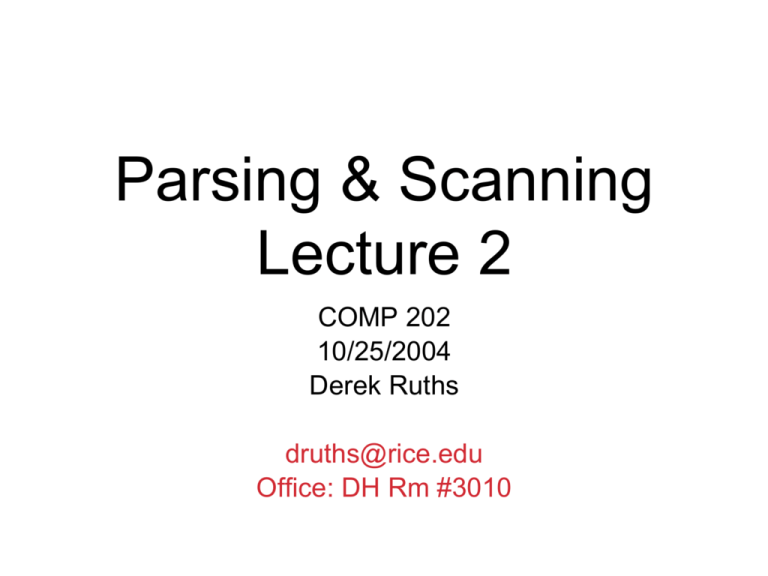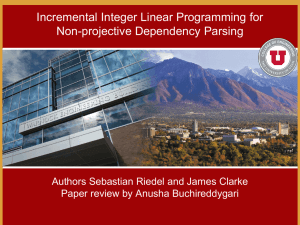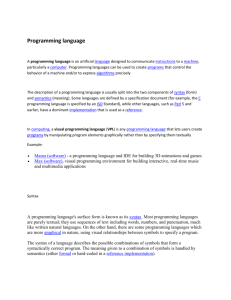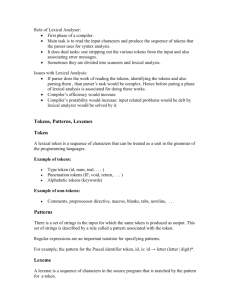PPT lecture #2
advertisement

Parsing & Scanning
Lecture 2
COMP 202
10/25/2004
Derek Ruths
druths@rice.edu
Office: DH Rm #3010
High-Level View
Text,
Source
Code,
Speech
Scanner
Parser
Structured
Representation
(e.g. Abstract
Syntax Tree)
•
Overview
Lecture 1:
•
•
•
•
•
Intro to scanning
Intro to parsing
Basics of building a scanner in Java
Lab: Implementing a scanner and simple
parser
Lecture 2:
•
•
Basic Parsing Theory
Design of an Object-Oriented Parser
Parsing:
Organizing Things
Grammar
<NUM, “3”>,
<PLUS, “+”>,
<ID,
“x”>,
<EOF>
Tokens
+
Parser
3
x
Abstract Syntax
Tree
What is Grammar?
Two very similar statements
with very different meanings
Q: Are you running?
A: You are running.
1) “you” and “are” switch places - token order
2) “.” instead of “?” - token type
Goal of Grammar:
To derive syntactical structure from order and type of tokens.
Arrangements of
Tokens
“mmmm ... 3 x + ... yes” ~ Yoda
“Syntax Error!” ~ Parser
Not all combinations
and orderings of token
types are valid.
Syntax vs. Semantics
Local property
Syntax: the structure of a set of tokens
Semantics: the meaning of a set of tokens
and a syntactical structure.
Global property
x = “Hello”
...
y=3+x
Syntax: VAR EQUALS NUM PLUS VAR
Semantics: y = 3 + “Hello”
Invalid semantics
Extension of CalcGrammar (from lab)
Production Rules
1.
2.
3.
4.
5.
6.
Expression: 3 + x + 2
Expr → Fact Non-Terminals
Look Ahead
Expr → Fact Op Expr
How many tokens
Fact → NUM
must be read to
Fact → ID
Terminals
decide on the
Op → PLUS
production rule to
Op → MINUS
use?
Derivation: Apply rules to
transform Expr into a specific
token sequence.
LL(1) grammars have
only one production.
Designing ContextFree Grammars
• Design LL(1) grammars for these
languages:
• A list of names
• A list of alternating words and
numbers
• The Extended Calc-Grammar with
assignments (e.g. “x = y + 2”)
Parsing:
Organizing Things
Grammar
<NUM, “3”>,
<PLUS, “+”>,
<ID,
“x”>,
<EOF>
Tokens
+
Parser
3
x
Abstract Syntax
Tree
Representing
Syntax Structure
Production Rule
Syntax Tree
Expr
Expr → Fact Op Expr
Fact → NUM
Op → PLUS
Fact
Op
Expr
Expr → Fact
Fact → ID
NUM
PLUS
Fact
ID
Implementing a
Parser the OO-Way
<num: (”0”-”9”)+>
<id: (alpha)+>
<plus: “+”>
Text
Scanner
E :: F E1
E1 :: E1a | empty
E1a :: + E
F :: F1 | F2
F1 :: num
F2 :: id
Parser
Structured
Representation
Why use OOP for
Parsing?
Small change in design
Small change in code
Local change in design
Local change in code
• Easy to add a new token
• Easy to add a new production rule
OOP Parsing: Key
Ideas
Everything is an object
Intelligent Token/Terminal
Decides production
rule to use
Ignorant Non-Terminal
Only knows its
production rules
Everything is an
Object
E :: F E’
E’ :: empty | + E
F :: num | id
Intelligent Tokens
Token is given a list
of candidate
productions
Token choses a
production and executes
it
Production creates the
correct Non-Terminal
E :: F E1
E1 :: E1a | empty
E1a :: + E
F :: F1 | F2
F1 :: num
F2 :: id
But the NT might need to
construct another NT!
Non-Terminal
Factories E :: F E1
•public class EFact extends ATVFactory {
• private FFact _fFact;
•
private ITokVisitor _parseF;
private E1Fact _e1Fact;
private ITokVisitor _parseE1;
•
public EFact(ITokenizer tkz, FFact fFact, E1Fact e1Fact) {
_parseF = _fFact.makeVisitor();
_parseE1 = _e1Fact.makeVisitor();
}
public ITokVisitor makeVisitor() {
return new ITokVisitor() {
public Object defaultCase(AToken host, Object param) {
return new E((F) host.execute(_parseF, param), (E1) nextToken().execute(_parseE1, param));
}
};
}
public ITokVisitor makeChainedVisitor(final ITokVisitor successor) {
return new ITokVisitor() {
public Object defaultCase(AToken host, Object inp) {
Object o = host.execute(_fFact.makeChainedVisitor(successor), inp);
return (o instanceof F) ? new E((F) o, (E1) nextToken().execute(_parseE1, inp)) : o;
}
};
}
}
E1 :: E1a | empty
E1a :: + E
F :: F1 | F2
F1 :: num
F2 :: id
Intelligent Tokens
Token is given a list of
candidate productions
Token choses a production
and executes it
Production creates the
correct Non-Terminal
E :: F E1
E1 :: E1a | empty
E1a :: + E
F :: F1 | F2
F1 :: num
F2 :: id
How can we choose
a production?
But the NT might need to
construct another NT!
Choosing a Production:
A New Visitor Pattern
•
•
•
public abstract class AToken { public abstract Object execute(ITokViz algo, Object param); }
public interface ITokViz { public Object defaultCase(AToken host, Object param); }
public class NumToken extends AToken {
public static interface INumVisitor extends ITokViz {
public Object numCase(NumToken host, Object param);
}
public static abstract class AChainViz implements INumVisitor {
private ITokViz _successor;
•
•
•
•
•
•
•
•
•
•
•
}
A list of visitors
Easy to add
protected AChainViz(ITokViz succ) { _successor = succ; }
productions!
public Object defaultCase(AToken host, Object param) { return host.execute(_successor,
param); }
}
public Object execute(ITokViz algo, Object param) {
return (algo instanceof INumVisitor)? ((INumVisitor) algo).numCase(this, param):
algo.defaultCase(this, param);
}
•
•
Handles variant hosts Easy to add tokens!
Tying it together:
Chaining Productions
•public class FFact extends ATVFactory {
•
private F1Fact _f1Fact;
private F2Fact _f2Fact;
public FFact(ITokenizer tkz, F1Fact f1Fact, F2Fact f2Fact) {
super(tkz);
_f1Fact = f1Fact;
_f2Fact = f2Fact;
}
E :: F E1
E1 :: E1a | empty
E1a :: + E
F :: F1 | F2
F1 :: num
F2 :: id
public ITokVisitor makeVisitor() {
return _f1Fact.makeChainedVisitor(_f2Fact.makeVisitor());
}
public ITokVisitor makeChainedVisitor(ITokVisitor successor) {
return _f1Fact.makeChainedVisitor(_f2Fact.makeChainedVisitor(successor));
}
}
Why will there only be one visitor per token type for any
given chain of productions?
Ignorant NonTerminals
num
Our LL(1) Grammar
E → F E’
E :: F E’
E’ :: empty | + E
F :: num | id
id
E’
empty
+
OO Parsing Review
•
Intelligent Tokens
•
•
Each token provides a visitor type and a
way to make that visitor belong to a list
Ignorant Non-Terminals (NT)
•
•
Only knows its production: its factory
produces a visitor that represents its
production
Can’t build other NT types: each NT has a
factory that provides a token visitor that can
construct the NT.








